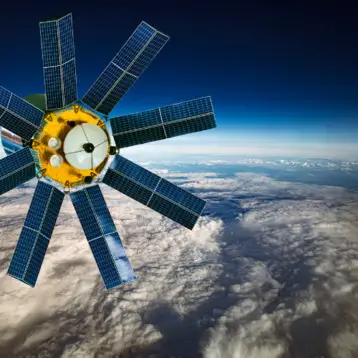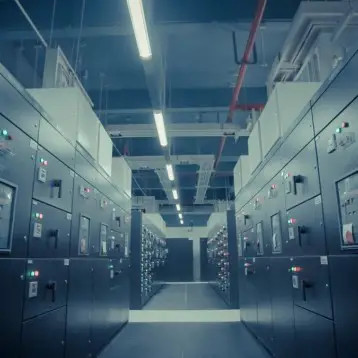|
Hard disk drives have been around for decades. The first hard drive was part of a computer system built by IBM in the mid 1950’s called IBM 305 RAMAC that was used to process accounting information. Although it occupied almost half a room, cost around $50,000, and had only 5 Mb of storage, it is still considered a highly innovative device for its time. Since then, although hard drives have become continuously smaller, cheaper, and their storage capacities have grown over 100,000-times, the basic technology has remained the same. Rapidly spinning platters coated with ferromagnetic material hold the data, while a special actuator arm equipped with a read/write head hovers just above it. Despite the fact that this technology reached a very high level of maturity in recent years (for instance, the actuator arm hovers just nanometers above the spinning platter without crashing the disk), it still suffers from a number of basic limitations due mainly to its mechanical nature. Hard drives are vulnerable to shock, consume relatively high amounts of power in order for the platters to spin, produce a large amount of heat, and take time to start.
|
In 1984, Dr. Fujio Masuoka from Toshiba invented the first flash memory, which Intel introduced as a commercial product four years later. Solid state drives based on flash memory have a number of unique advantages over conventional hard drive technology. Since they lack mechanical parts, they are much more resistant to shock, consume far less power, and release far less heat. They also produce no sound during operation and respond much more quickly than a mechanical drive. The size of a flash drive can also be very small (relative to a mechanical hard drive), resulting in a lighter device. All these advantages beg the question ‘Why are we still using what might seem as an outdated mechanical hard drive technology?’ Rochelle Singer, Marketing and Technical Documentation Manager at msystems (recently acquired by SanDisk) explained to TFOT the two main reasons why more than 20 years following their invention, flash drives have not yet replaced hard drives in mobile PCs: “The most important reason is the poor price to capacity ratio of flash memory compared to hard disk drives. When solid state disks were first brought to the military and aerospace markets by msystems in 1989, 1 MB of flash cost a few thousand dollars. At the time, the same capacity inside a hard disk drive cost in the range of tens of dollars. But despite its clearly inferior pricing, the solid state disk gained wide acceptance in the military sector because, unlike the hard disk drive, it was able to meet very strict reliability requirements for field operation in extreme conditions of shock, vibration, altitude, and temperature ranges.
|
Today, as flash prices continue to decline 50% annually and sometimes even at higher rates – this year flash prices have dropped a phenomenal 70% since January – the solid state disk is gaining entree into new markets. Currently a 4 GB flash memory retails for around the same price as a 120 GB hard drive. Although hard disk drives still have the price edge – building even a relatively small drive based solely on flash memory costs hundreds of dollars at current prices – analysts agree that the trend in cost reduction is expected to continue. The recent success of MP3 players based on flash memory has contributed greatly to high volumes and, therefore, reduced prices of the media. It is not inconceivable that in two years, flash-based drives will hold a two-digit share of the hard drive mobile PC market.
The second obstacle that blocked the uptake of flash was the large footprint required. When flash was first introduced, it was more than five times the size of a hard disk drive of the same capacities. In mobile PCs, the limited size allocated for hard disk drives, usually a 2.5” or 1.8” casing, made it impossible for flash to compete up until only very recently, since it could not deliver enough capacity in such a small footprint.
As new etching processes and technologies are implemented, the capacity of flash is doubling every year and its footprint is becoming smaller. Finer etching processes down to 50 nm in 2007 (as compared to 90 nm in 2005) and more advanced technologies such as multi-level cell (MLC) NAND, which stores 2 bits/cell – instead of single-level cell (SLC) NAND, which stores only 1 bit/cell – continue to enable less silicon to be used to produce ever higher capacities in ever smaller footprints.
|
These cost and size economies come at a price: flash has become more difficult to manage to deliver the high reliability and endurance that have become its trademark. This entails the need for more sophisticated flash management to make sure that flash endurance (measured as the number of write/erase cycles that it can endure without degrading data reliability) can meet market requirements. Error detection and correction must be robust enough to combat the exponentially increasing number of errors as the media becomes increasingly dense. msystems, the first company to bring MLC NAND to the mobile handset market 3 years ago, has proven that it is capable of delivering the required reliability and endurance.”
Samsung, the first to come out with a consumer Solid State Disk (SSD), decided to test out the technology on laptops and portable devices first, releasing 32 GB 1.8” and 2.5” SSDs inside a laptop and an ultra-portable mobile computer, costing $2,430 and $3,700, respectively, in Korea. Other solid-state drive manufacturers will join the ranks in the very near future, using both SLC and MLC NAND flash. In the meantime, and until flash memory prices drop, Samsung is building on the introduction of the midterm solution – the hybrid hard drive (covered in a previous TFOT article), which uses a combination of flash memory and conventional hard drive design.
Interview with Samsung
To learn more about Samsung’s SSD technology, TFOT interviewed Don Barnetson, Director of Flash Marketing for Samsung Semiconductor.
Q: How fast is your current SSD and what performance improvements does it offer?
A: The streaming R/W speeds are 57 MB/s and 32 MB/s, respectively, but the most significant performance advantage comes from its latency feature – less than 1 millisecond; roughly 10-15x faster than a hard disk drive.
Q: Is there currently some sort of technical limitation on the creation of SSDs other than cost, and what about the reliability of flash media?
A: Historically SSDs were limited in the number of R/W cycles. However, with modern flash technology and error correction, the reliability of the flash in a PC exceeds 10 years. Cost is currently the barrier. However, flash pricing has historically come down 40% per year over the past 10 years. Thus, densities that were unaffordable only a few years ago are practical today; the same will hold true in the future.
Q: Why did you choose to start with portable (1.8”/2.5”) SSDs and not include desktop (3.5”) versions as well? When should we expect a desktop version of the SSD? A: Several key values of SSD are most applicable to notebooks (95% power reduction, virtually impervious to shock and vibration, no noise, weight reduction), though performance gains would be apparent in both segments. The limitation on density is not a function of physical size – we could put much more than 32 GB in the 1.8” or 2.5” form factors. It is more an economic limitation, and this would not be resolved by going to a 3.5” form factor.
Q: Is it possible to increase the R/W speed of the SSD drive?
|
A:
It is possible to increase streaming read/write speeds by interleaving more flash components. However, streaming R/W speeds are seldom the bottleneck in PCs; streaming performance has been the focus of specification one-upmanship in the HDD industry. In actual usage, however, as Microsoft discussed at WinHEC, random I/O is almost always the bottleneck with real performance. In this case, our SSDs offer up to 5000 IOPS (I/O operations per second) vs. approximately 100 IOPS on a consumer-grade HDD. This is the key reason why a notebook equipped with an SSD can respond 4x more quickly to standard Vista operations (loading applications, etc.) than a similarly equipped HDD-based notebook at WinHEC.Q: Why is your current SSD drive PATA and not SATA and will future SSDs be able to take advantage of the SATA-II bandwidth?
A: SATA-based SSDs will be offered in the future. Since the streaming R/W performance of our SSD does not currently exceed that of either the PATA or SATA-I interfaces, it is unclear whether building an SSD with faster read performance would necessarily make any difference to system-level performance for the reason mentioned above.
|
Q: How much will your SSD drive cost?






_thumb.jpg)









